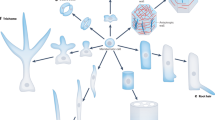Summary
The three-dimensional arrangement of the polysaccharide chains in cell walls was investigated, using ultracryotomy and cytochemistry, in order to test the validity of the previously postulated “ordered fibril hypothesis” and to analyze the characteristics of the primary wall morphogenesis.
Both in mung bean hypocotyl (Phaseolus aureus) and pea root (Pisum sativum) cultured in defined conditions, cell to cell endogenous specificity is marked by differences in the numbers of layers, thickness, rhythm and direction of deposition. The occurrence of bow-shaped arrangements and of strata of orientation intermediate between the main crisscrossed multifibrillar layers suggests that the sequential changes of the morphogenetic activity of the cells is progressive. The twisted polysaccharide disposition evokes certain mesomorphic states; a part of the mechanism responsible for the wall arrangement may result from a self-assembly process as in the orientation of the molecules in a liquid cristal. This possibility finds experimental support in the fact that a three-dimensional association of the hemicellulose chains spontaneously appears when precipitated in acellular conditions.
Polysaccharide removal associated with shadowing indicates that the ordered disposition within the wall is extensively altered by even a slight extraction. These data may invalidate diverse results which are generally brought forward to explain the wall organization during growth.
Similar content being viewed by others
References
Beveridge, T. J., andR. G. E. Murray, 1976: Reassemblyin vitro of the superficial cell wall components ofSpirillum putridiconchylium. J. Ultrastruct. Res.55, 105–118.
Bouck, G. B., andD. L. Brown, 1976: Self assembly in development. Ann. Rev. Plant Physiol.27, 71–94.
Bouligand, Y., 1974: Twisted fibrous arrangements in biological materials and cholesteric mesophases. Tissue and Cell4, 189–217.
—, 1976: Les analogues biologiques des cristaux liquides. La Recherche67, 474–476.
Boyd, J. D., andR. C. Foster, 1975: Microfibrils in primary and secondary wall develop trellis configurations. Canad. J. Bot.53, 2687–2701.
Brown, R. M., andD. Montezinos, 1975: Cellulose microfibrils: visualization of the biosynthetic and orienting complexes in the plasma membrane. Proc. nat. Acad. Sci.73, 143–148.
Chafe, S. C., 1974: Cell wall structure in the xylem parenchyma ofCryptomeria. Protoplasma81, 63–76.
—, andG. Chauret, 1974: Cell wall structure in the xylem parenchyma of trembling aspen. Protoplasma80, 129–147.
—, andA. B. Wardrop, 1972: Fine structural observations on the epidermis. I. The epidermal cell wall. Planta107, 269–278.
Franz, G., 1972: Polysaccharidmetabolismus in den Zellwänden wachsender Keimlinge vonPhaseolus aureus. Planta102, 334–347.
Frey-Wyssling, A., 1953: Submicroscopic morphology of protoplasm. Amsterdam: Elsevier Publishing Company.
—, andK. Mühlethaler, 1965: Ultrastructural plant cytology. Amsterdam: Elsevier Publishing Company.
Hills, G. J., 1973: Cell wall assemblyin vitro fromChlamydomonas reinhardi. Planta115, 17–23.
Itoh, T., 1975 a: Cell wall organization of cortical parenchyma of Angiosperms observed by the freeze-etching technique. Bot. Mag. (Tokyo)88, 145–156.
—, 1975 b: Application of freeze-etching technique for investigating cell wall organization of parenchyma cells in higher plants. Wood Res.58, 20–32.
Kerr, A. J., andD. A. I. Goring, 1975: The ultrastructural arrangement of the wood cell wall. Cellulose Chem. Technol.9, 563–573.
Parameswaran, N., 1975: Zur Wandstruktur von Sklereiden in einigen Baumrinden. Protoplasma85, 305–314.
— andW. Liese, 1975: On the polylamellate structure of parenchyma wall inPhyllostachys edulis Riv. Iawa Bulletin4, 57–58.
Preston, R. D., 1973: The physical biology of plant cell walls. London: Chapman and Hall.
Reis, D., 1976: Evolution qualitative et quantitative des sécrétions de parois pendant les phases de croissance des cellules de l'hypocotyle dePhaseolus aureus. Bull. Soc. Bot., in press.
— andJ. C. Roland, 1974: Mise en évidence de lórganisation des parois des cellules végétales en croissance par extractions ménagées des polysaccharides associées à la cytochimie ultrastructurale. J. Microscopie20, 271–284.
Robenek, H., andE. Peveling, 1975: Veränderungen des Plasmalemmas während der Zellwandregeneration an isolierten Protoplasten aus dem Sproßkallus vonSkimia japonica Thunb. Planta127, 281–284.
Robinson, C., 1966: The cholesteric phase in polypeptide solutions and biological structures. Mol. Crystals1, 467–494.
Robinson, D. D., andR. D. Preston, 1972: Plasmalemma structure in relation to microfibril biosynthesis inOocystis. Planta104, 234–246.
Roelofsen, P. A., 1959: The plant cell wall. Berlin: Gebrüder Borntraeger.
— andA. L. Houwink, 1953: Architecture and growth of the primary cell wall in some plant hairs and in thePhycomyces sporangiophore. Acta Bot. Ner.2, 218–225.
Roland, J. C., 1973: The relationship between the plasmalemma and plant cell wall. Int. Rev. Cytol.36, 45–92.
—,B. Vian, andD. Reis, 1975: Observations with cytochemistry and ultracryotomy on the fine structure of the expanding walls in actively elongating plant cells. J. Cell Sci.19, 239–259.
Sawhney, V. K., andL. M. Srivastava, 1975: Wall fibrils and microtubules in normal and gibberellic-acid-induced growth of lettuce hypocotyl cells. Canad. J. Bot.53, 824–835.
Schnepf, E., G. Röderer, andW. Herth, 1975: The formation of the fibrils in the Lorica ofPoteriochromonas stipitata: Tip Growth, Kinetics, Site, Orientation. Planta125, 45–62.
Willison, J. H. M., 1976: An examination of the relationship between freeze-fractured plasmalemma and cell wall microfibrils. Protoplasma88, 187–200.
Author information
Authors and Affiliations
Rights and permissions
About this article
Cite this article
Roland, J.C., Vian, B. & Reis, D. Further observations on cell wall morphogenesis and polysaccharide arrangement during plant growth. Protoplasma 91, 125–141 (1977). https://doi.org/10.1007/BF01276728
Received:
Revised:
Issue Date:
DOI: https://doi.org/10.1007/BF01276728




